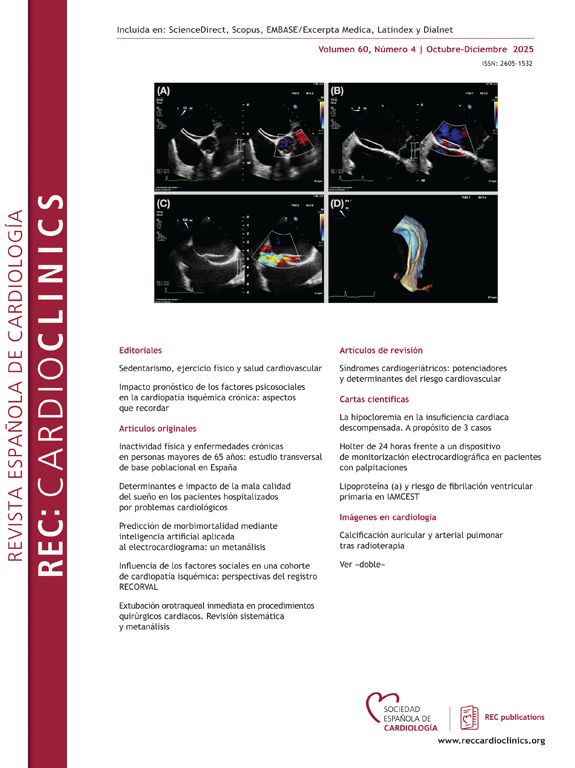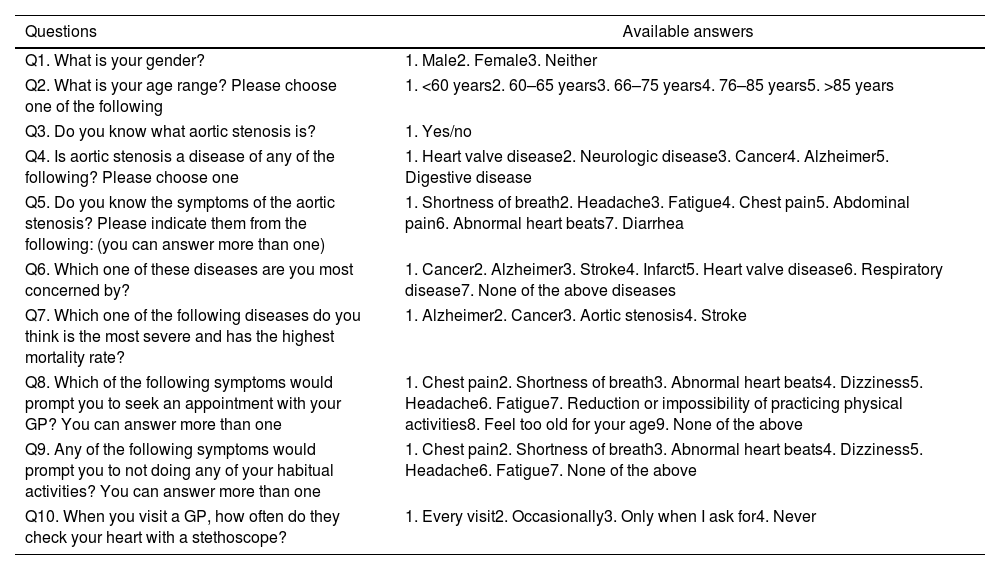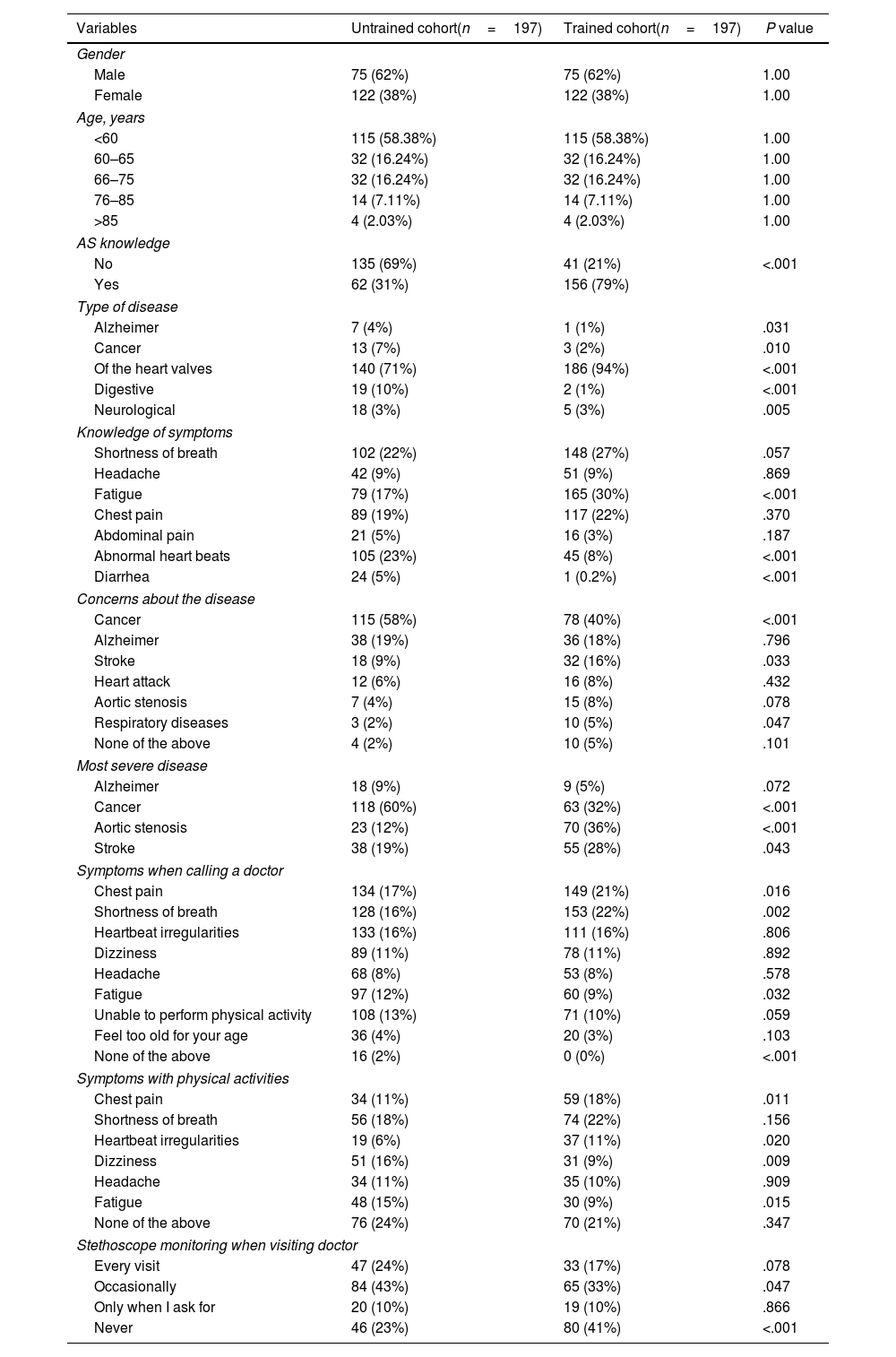Aortic stenosis (AS) is a prevalent disease, particularly in the elderly population, with an approximate prevalence of 7% in population over 85 years old in Spain.1 Nevertheless, results from the European Heart Health Survey show low levels of AS awareness among European general population.2 This survey (over 12000 people) reported AS as difficult to define with only 5.6% of respondents correctly describing it.2 The limited knowledge on the disease, symptoms, and treatment may cause significant delays in patients who should seek help from a professional, setting back their diagnosis and treatment. This situation might also lead to major negative effects on individual outcomes and increased healthcare costs due to increased complexity (more advanced disease stages at the moment of diagnosis).
Effective communication between healthcare professionals and patients is highly correlated with positive health effects on identification of symptoms, diagnostic, prognosis, treatment outcome and recovering from diseases.3 We investigated the impact of an educational program for the general population on AS related symptoms, the level of concern on AS, and its outcomes.
Patients attending outpatient consultation of a tertiary hospital and 6 primary care centers in Barcelona (Spain) were invited to participate in the study. Initially, patients were invited to answer a self-developed knowledge questionnaire on AS without specific training (untrained group). Afterwards, additional patients were invited to undergo a short education on AS by watching a 2-min educational video, and 24h later they were contacted to answer the questionnaire through a phone call (trained group).
The questionnaire was in accordance with the Data Protection Act, the International Committee of Medical Journal Editors recommendations on Protection of Research Participants, and the Declaration of Helsinki. The present study is part of a bigger study on AS, that was approved by our institution's ethics committee (REF N°HCB/2021/1198).
Questions in the survey assessed the levels of awareness of AS as a disease and its related symptoms, outcomes, and knowledge of heart valve disease. In addition to age and gender, the survey contained 8 multiple choice questions (Table 1). Propensity score matching of the 2 cohorts was conducted for gender and age to achieve a balanced sample on baseline demographics and Chi-squared test was used to determine statistical significance.
Survey questions and multiple-choice answers.
| Questions | Available answers |
|---|---|
| Q1. What is your gender? | 1. Male2. Female3. Neither |
| Q2. What is your age range? Please choose one of the following | 1. <60 years2. 60–65 years3. 66–75 years4. 76–85 years5. >85 years |
| Q3. Do you know what aortic stenosis is? | 1. Yes/no |
| Q4. Is aortic stenosis a disease of any of the following? Please choose one | 1. Heart valve disease2. Neurologic disease3. Cancer4. Alzheimer5. Digestive disease |
| Q5. Do you know the symptoms of the aortic stenosis? Please indicate them from the following: (you can answer more than one) | 1. Shortness of breath2. Headache3. Fatigue4. Chest pain5. Abdominal pain6. Abnormal heart beats7. Diarrhea |
| Q6. Which one of these diseases are you most concerned by? | 1. Cancer2. Alzheimer3. Stroke4. Infarct5. Heart valve disease6. Respiratory disease7. None of the above diseases |
| Q7. Which one of the following diseases do you think is the most severe and has the highest mortality rate? | 1. Alzheimer2. Cancer3. Aortic stenosis4. Stroke |
| Q8. Which of the following symptoms would prompt you to seek an appointment with your GP? You can answer more than one | 1. Chest pain2. Shortness of breath3. Abnormal heart beats4. Dizziness5. Headache6. Fatigue7. Reduction or impossibility of practicing physical activities8. Feel too old for your age9. None of the above |
| Q9. Any of the following symptoms would prompt you to not doing any of your habitual activities? You can answer more than one | 1. Chest pain2. Shortness of breath3. Abnormal heart beats4. Dizziness5. Headache6. Fatigue7. None of the above |
| Q10. When you visit a GP, how often do they check your heart with a stethoscope? | 1. Every visit2. Occasionally3. Only when I ask for4. Never |
GP, general practitioner.
A total of 64 approached participants from the trained cohort did not respond the questionnaire while all participants in the untrained cohort answered it. After matching, 394 people were included in the final analysis (197 from each cohort). Table 2 shows the answers to the questionnaire in both cohorts.
Results from the survey.
| Variables | Untrained cohort(n=197) | Trained cohort(n=197) | P value |
|---|---|---|---|
| Gender | |||
| Male | 75 (62%) | 75 (62%) | 1.00 |
| Female | 122 (38%) | 122 (38%) | 1.00 |
| Age, years | |||
| <60 | 115 (58.38%) | 115 (58.38%) | 1.00 |
| 60–65 | 32 (16.24%) | 32 (16.24%) | 1.00 |
| 66–75 | 32 (16.24%) | 32 (16.24%) | 1.00 |
| 76–85 | 14 (7.11%) | 14 (7.11%) | 1.00 |
| >85 | 4 (2.03%) | 4 (2.03%) | 1.00 |
| AS knowledge | |||
| No | 135 (69%) | 41 (21%) | <.001 |
| Yes | 62 (31%) | 156 (79%) | |
| Type of disease | |||
| Alzheimer | 7 (4%) | 1 (1%) | .031 |
| Cancer | 13 (7%) | 3 (2%) | .010 |
| Of the heart valves | 140 (71%) | 186 (94%) | <.001 |
| Digestive | 19 (10%) | 2 (1%) | <.001 |
| Neurological | 18 (3%) | 5 (3%) | .005 |
| Knowledge of symptoms | |||
| Shortness of breath | 102 (22%) | 148 (27%) | .057 |
| Headache | 42 (9%) | 51 (9%) | .869 |
| Fatigue | 79 (17%) | 165 (30%) | <.001 |
| Chest pain | 89 (19%) | 117 (22%) | .370 |
| Abdominal pain | 21 (5%) | 16 (3%) | .187 |
| Abnormal heart beats | 105 (23%) | 45 (8%) | <.001 |
| Diarrhea | 24 (5%) | 1 (0.2%) | <.001 |
| Concerns about the disease | |||
| Cancer | 115 (58%) | 78 (40%) | <.001 |
| Alzheimer | 38 (19%) | 36 (18%) | .796 |
| Stroke | 18 (9%) | 32 (16%) | .033 |
| Heart attack | 12 (6%) | 16 (8%) | .432 |
| Aortic stenosis | 7 (4%) | 15 (8%) | .078 |
| Respiratory diseases | 3 (2%) | 10 (5%) | .047 |
| None of the above | 4 (2%) | 10 (5%) | .101 |
| Most severe disease | |||
| Alzheimer | 18 (9%) | 9 (5%) | .072 |
| Cancer | 118 (60%) | 63 (32%) | <.001 |
| Aortic stenosis | 23 (12%) | 70 (36%) | <.001 |
| Stroke | 38 (19%) | 55 (28%) | .043 |
| Symptoms when calling a doctor | |||
| Chest pain | 134 (17%) | 149 (21%) | .016 |
| Shortness of breath | 128 (16%) | 153 (22%) | .002 |
| Heartbeat irregularities | 133 (16%) | 111 (16%) | .806 |
| Dizziness | 89 (11%) | 78 (11%) | .892 |
| Headache | 68 (8%) | 53 (8%) | .578 |
| Fatigue | 97 (12%) | 60 (9%) | .032 |
| Unable to perform physical activity | 108 (13%) | 71 (10%) | .059 |
| Feel too old for your age | 36 (4%) | 20 (3%) | .103 |
| None of the above | 16 (2%) | 0 (0%) | <.001 |
| Symptoms with physical activities | |||
| Chest pain | 34 (11%) | 59 (18%) | .011 |
| Shortness of breath | 56 (18%) | 74 (22%) | .156 |
| Heartbeat irregularities | 19 (6%) | 37 (11%) | .020 |
| Dizziness | 51 (16%) | 31 (9%) | .009 |
| Headache | 34 (11%) | 35 (10%) | .909 |
| Fatigue | 48 (15%) | 30 (9%) | .015 |
| None of the above | 76 (24%) | 70 (21%) | .347 |
| Stethoscope monitoring when visiting doctor | |||
| Every visit | 47 (24%) | 33 (17%) | .078 |
| Occasionally | 84 (43%) | 65 (33%) | .047 |
| Only when I ask for | 20 (10%) | 19 (10%) | .866 |
| Never | 46 (23%) | 80 (41%) | <.001 |
AS, aortic stenosis.
The trained cohort identified better what AS was, relating it to heart valve diseases and correctly identifying its associated symptoms. Even though AS was not as concerning to the general population as it was cancer or neurodegenerative diseases; a tendency toward more concern for AS was seen in the trained cohort (twice compared to the untrained cohort). Cancer and AS were deemed the most severe diseases in the untrained and trained group, respectively. The trained group also better identified symptoms that should lead to a medical consultation, specifically increasing the awareness on chest pain and shortness of breath symptoms. Finally, approximately 32% of the population surveyed stated that the general practitioner (GP) never checked their heart with a stethoscope during consultation, with a higher proportion among trained population.
These results confirm those from previous studies,2 the AS is not known among the general population. A simple educational intervention such as a short video can increase disease awareness. General population had baseline low levels of concern for AS compared to other diseases. The lack of concern for AS may be because there is a large media pressure on information about other diseases, such as Alzheimer's disease/stroke,4,5 not seen for AS, which corroborates the current general illiteracy regarding AS, its symptoms and severity.
As shown in our study, over 75% of people attending the GP in our study were not regularly checked with a stethoscope, a similar rate to that reported in previous survey results,2 being 76% and 83% for the untrained and trained cohort, respectively. AS diagnosis and management guidelines recommend performing stethoscope checks in patients with AS symptoms to early detect, follow-up, and treat AS patients accordingly.6 Reasons underlying this low rate were not investigated but could include limited time for medical consultation, or low awareness among general physicians on the potential of cardiac auscultation. However, trained participants could have had recall bias as they were told what should have been the gold standard in consultation.
Compared to the previous study by Gaede et al.2 conducted in different European countries, this study shows a higher awareness on AS in the studied population (5.6% vs 31.5%).2 These differences could result from using different methods to assess the knowledge on AS. Gaede et al.2 used qualitative assessment methods based on open-ended questions asked to people recruited in non-healthcare related sites. The present research was performed in healthcare centers with quantitative assessment methods based on a multiple-choice question and deemed right with 3 correctly answered symptoms. People attending healthcare facilities could be more aware of diseases than people not attending health care facilities so selection bias cannot be excluded.
The study is not free of limitations. Additional sociodemographic variables should be collected to ensure comparability of the groups. Moreover, the video might be revised to increase the effectiveness in information retention by the general population. Lastly, the follow-up to assess the knowledge could be extended to 1 month instead of next day to ensure proper information retention.
This study shows that in accordance with previous surveys, there is a low knowledge level about AS in the general population. The study shows that a short educational program with a 2-min video can improve the knowledge on AS among the general population and provide them with necessary essential information to identify the disease and decide whether to request a GP consultation. This can contribute to better symptoms identification, appropriate and timely consultation for healthcare assistance, and potentially to earlier and more effective diagnosis and treatment of AS.
FundingMITMEVA project. Program financed by FEDER call and under the operational funds 2014–2020 from the Catalan Health Services (CatSalut).
Ethical considerationsThe present study is part of a bigger study on AS and was approved by our institution's the Ethics Committee (REF N°HCB/2021/1198). The survey was fully compliant and in accordance with the Data Protection Act, the ICMJE Protection of Research Participants as well as with the Declaration of Helsinki. Possible sex/gender biases have been taken into account in the preparation of this paper.
Statement on the use of artificial intelligenceNo artificial intelligence tool was neither used to prepare this article nor during the investigation.
Authors’ contributionsConceptualization was conducted by C. Fernández-Barceló, B. Vidal, P. González, L. Sampietro-Colom, M. Sitges. C. Fernández-Barceló and I. Abbas oversaw data curation, formal analysis, and investigation. Funding was acquired by B. Vidal, L. Sampietro-Colom and M. Sitges. C. Fernández-Barceló, I. Abbas, L. Sampietro-Colom oversaw the methodology. The project was administered by P. González, L. Sampietro-Colom, M. Sitges. C. Fernández-Barceló, B. Vidal, L. Sampietro-Colom, M. Sitges supervised the work. Validation was assigned to C. Fernández-Barceló, B. Vidal, I. Abbas, P. Gonzalez, L. Sampietro-Colom, and M. Sitges. C. Fernández-Barceló, I. Abbas prepared the original draft. C. Fernández-Barceló, B. Vidal, P. González, L. Sampietro-Colom, M. Sitges wrote, edited, and reviewed the final version.
Conflicts of interestP. González is an employee of Edwards LifeSciences, which has received funding from the MITMEVA project as part of the public procurement of innovation to carry out the activities described in the article. The remaining authors report no conflicts of interest.










